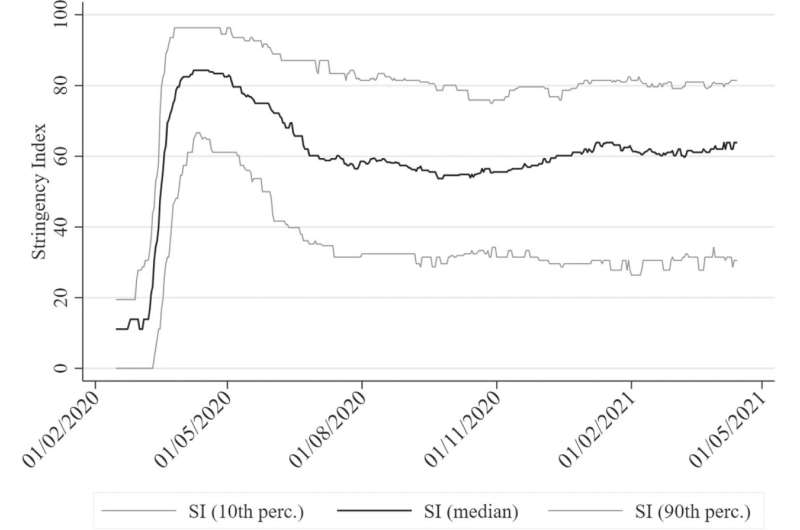This article has been reviewed according to Science X's editorial process and policies. Editors have highlighted the following attributes while ensuring the content's credibility:
fact-checked
peer-reviewed publication
trusted source
proofread
COVID-19 measures: How strict do they need to be?

"Pan metron ariston"—everything in moderation: Author Leonidas Spiliopoulos of the Max Planck Institute for Human Development uses this Greek phrase in the title of his current study. Spiliopoulos examined the effectiveness of lockdowns and other non-pharmaceutical interventions (NPIs) in curbing the spread of COVID-19 and limiting the number of deaths.
The study uncovers two important factors that can positively influence pandemic dynamics. The first is the voluntary behavioral changes that people make in response to both their personal assessment of the pandemic's severity and the signaling effect of political decisions. The second is the impressive success of extensive testing policies, which significantly reduced COVID-19 case and death growth rates without the negative social impact associated with many NPIs.
Spiliopoulos analyzed data from 132 countries collected between February 15, 2020 and April 14, 2021. The dataset includes information on confirmed cases and deaths, mobility data, testing rates, and the COVID-19 Stringency Index.
This index, developed by Oxford University, gauges the stringency of various NPIs—including school closures, stay-at-home mandates, cancelation or restriction of public events, international travel restrictions, and information campaigns—on a single measure to allow for easier comparisons across countries. The scale ranges from 0 (no restrictions at all) to 100 (the most extreme restrictions).
Moderately severe measures with a Stringency Index in the 31–40 range accounted for about 90% of the maximum effectiveness of NPIs. "In this range, the positive effects of these measures on the current pandemic dynamics were close to the practically achievable maximum while minimizing the impact on physical and mental health and the economic costs," says Spiliopoulos.
This range included restrictions on public gatherings of more than roughly 100 people, quarantine regulations for travelers from high-risk areas, public information campaigns, and various recommendations such as working from home, canceling events, or closing schools. The study also highlights the importance of extensive testing, which attained 50 percent of the impact of the optimal NPIs, without the significant negative societal disruption associated with the latter.
"In terms of rebalancing the policy mix for future pandemics, we should seriously consider leaning more heavily on early extensive testing and targeted public campaigns aimed at helping people make informed voluntary behavioral changes," Spiliopoulos says.
Surprisingly, the study also shows that a significant reduction in people's external mobility did not have the positive impact that was originally anticipated. Two prominent explanations are consistent with this observation.
First, while the spread of the virus outside the home may have been reduced, infection within the home may have been facilitated as families or roommates spent more time together.
Second, people's behavioral changes (e.g., social distancing, mask-wearing, switching to alternative safer transport) may have been effective enough to allow people to continue to commute and have limited contact with others without a significant increase in transmission. The study highlights the complexity of the issues at hand and the need to empirically test hypotheses about policy impact, as well as the importance of revisiting studies when further data is available in order to examine the robustness of early findings.
"This analysis allows us to draw more reliable conclusions than numerous previous studies, because the data were collected over a longer period and from a very wide range of countries," says Ralph Hertwig, Director of the Center for Adaptive Rationality at the Max Planck Institute for Human Development and member of the expert panel that advises the German government on the COVID-19 pandemic.
"At the beginning of the pandemic, uncertainty regarding the transmission and mortality of COVID-19 was high. Against that background, many countries decided initially on relatively restrictive policies," he says. The study's findings can inform public policy, particularly in terms of how to manage future pandemics with similar case and death rates during the critical period before vaccines are developed and rolled out.
More information: Leonidas Spiliopoulos, On the effectiveness of COVID-19 restrictions and lockdowns: Pan metron ariston, BMC Public Health (2022). DOI: 10.1186/s12889-022-14177-7



















